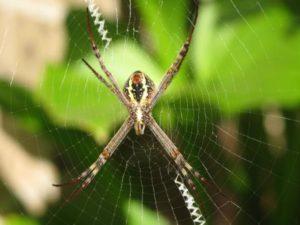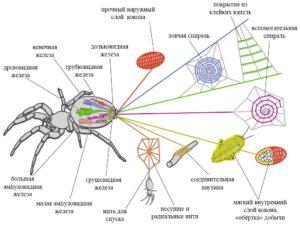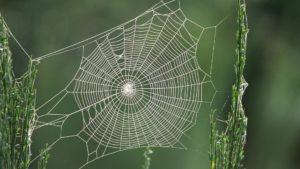How Spiders Weave Webs: Deadly Lace Technology
Getting stuck or getting caught in a web is not a very pleasant feeling. She is kind of sticky, flaky and very thin. You can get into it everywhere - between the trees, in the grass and on the ground. But there are a number of features of how a spider weaves a web, which makes it just that.
Content
What is spider web
The web itself is the secret of the spider glands that freeze in the air. It is produced in special spider warts, thin outgrowths on the edge of the abdomen.
As part of the web, the protein fibroin, which forms the fibers, makes them strong and elastic. For connection and attachment, the same matter is used, which is immersed in a special sticky gel secreted by other glands. They, from the anterior-lateral warts, also produce fiber, which is a slightly watery material that covers the threads themselves.
How a spider produces a web
The process itself is very interesting. Production goes like this:
- The spider presses the spider warts to the substrate.
- The secret sticks to it.
- The spider uses its hind legs to draw out the viscous mixture.
- Moving forward, the spider draws out the secret, and it freezes.
- The animal passes along the thread several times, thereby strengthening it.
Usage and functions
The fiber of the web is very strong, for comparison, it is similar to the density of nylon. According to some opinions, this is because the spider creates it while hanging on the same fiber.
It has interesting features:
- Tension. Although the threads are compressed, even stretched, they return to their usual place.
- Articulation. An object in the web can be rotated in one direction, and it will not twist or get tangled.
It is believed that the main function of the web is to catch prey. This is true, but it has a number of other important functions.
Spider food caught in the net is immobilized there. And they often wrap the prey itself in a web.
Males may begin the act of courting a female by tugging at her web to get her attention. Some species on the web leave seminal fluid to fertilize the female.
The eggs also develop in a web cocoon. In the same place, for some time, young animals are grown.
Water spiders make cocoons under water, they have air for breathing. Those who build burrows braid the inside of the dwelling with it.
Some species weave leaves into the web, which are puppets. Spiders move them when predators approach to deceive them.
Human use of the web
People are trying to create analogues of the web for use in medicine and construction. An American company is creating a prototype of the material to be used to make bulletproof vests. They will be strong and light.
Traditional medicine has not been spared. It is used as a blood stopper.
Web types
Depending on the type of spider, the shape of the finished web design is different. This, one might say, is a distinguishing feature.
Usually there are 3-4 bearing threads, which are the basis of the structure and are attached to the base with connecting disks. Radials converge towards the center, and spirals create a shape.
Curiously, the spider itself does not attach to its web and does not stick. He only touches the tips of the legs of the nets, and they have a special lubricant on them.
Round form
This beautiful light lace is a deadly weapon. The spider first makes a frame, then lays radial fibers towards the center, and at the end spiral threads are laid.
Prey falls into such a trap, and the hunter senses movement and gets out of the ambush. If a hole appears in the web, the spider completely interweaves the new one.
Strong web
This is a round or similar design with a large diameter. A network with a large number of cells is being prepared to catch large prey. There is a hammock - a structure in which spiders settle and wait for their prey. It is flat, located like a horizontal mattress, from which vertical threads extend along the edges for fastening.
Conclusion
The spider's web is a real masterpiece and a cunning engineering design. It is created competently and thoughtfully, performs a number of functions that provide comfort, nutrition and convenience to its owner.


